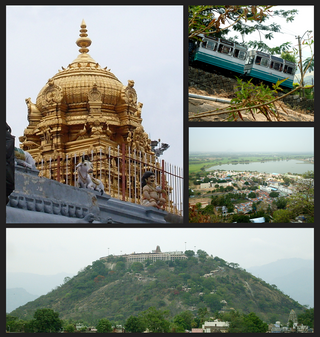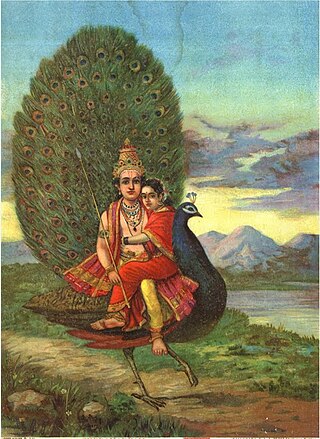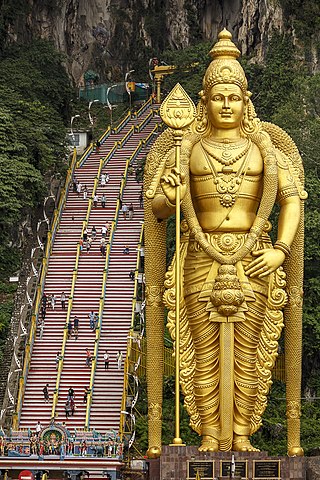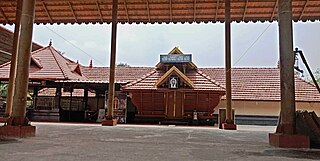
Parvati, Uma or Gauri is the Hindu goddess of power, energy, nourishment, harmony, love, beauty, devotion, and motherhood. She is a physical representation of Mahadevi in her complete form. She is also revered in her appearances as Durga and Kali. She is one of the central deities of the goddess-oriented sect called Shaktism, and the chief goddess in Shaivism. Along with Lakshmi and Saraswati, she forms the Tridevi.

The Ardhanarishvara, is a form of the Hindu deity Shiva combined with his consort Parvati. Ardhanarishvara is depicted as half-male and half-female, equally split down the middle. The right half is usually the male Shiva, illustrating his traditional attributes.

Palani (Tamil: [paɻani] or Palnias in British records, is a town and a taluk headquarters in Dindigul district of the western part of Tamil Nadu state in India. It is located about 106 kilometres south-east of Coimbatore and 122 kilometres north-west of Madurai, 67 kilometres from Kodaikanal. The Palani Murugan Temple or Arulmigu Dhandayuthapani Swamy Temple, dedicated to Lord Murugan is situated on a hill overlooking the town. The temple is visited by more than 7 million pilgrims each year. As of 2011, the town had a population of 126,751 which makes it the second largest town in the district after Dindigul.

Arunagirinaadhar was a Tamil Saiva saint-poet who lived during the 15th century in Tamil Nadu, India. In his treatise A History of Indian Literature (1974), Czech Indologist Kamil Zvelebil places Arunagirinathar's period between circa 1370 CE and circa 1450 CE. He was the creator of Thiruppugazh, Tiruppukaḻ, [tiɾupːɯɡaɻ], meaning "Holy Praise" or "Divine Glory"), a book of poems in Tamil in praise of lord Murugan.

Kundrathur is a south western suburb of the city of Chennai, India and it comes under Kanchipuram District limits. It is the birthplace of Sekkizhar, a well-known poet-saint who authored the Periyapuranam.

Swaminatha Swamy Temple is a Hindu temple dedicated to god Murugan. It is located in Swamimalai, 5 km from Kumbakonam, on the banks of a tributary of river Kaveri in Thanjavur District, 250 km from Chennai, the capital of Tamil Nadu, India. The temple is fourth abode of Murugan among six (Arupadaiveedugal). The shrine of the presiding deity, Swaminathaswamy is located atop a 60 ft (18 m) hillock and the shrine of his mother Meenakshi (Parvathi) and father Shiva (Sundareswarar) is located downhill. The temple has three gopuram, three precincts and sixty steps and each one is named after the sixty Tamil years. The temple has six daily rituals at various times from 5:30 a.m. to 9 p.m., and three yearly festivals on its calendar. The annual Vaikasi Visagam festival is attended by thousands of devotees from far and near.

Arulmigu Dhandayuthapani Swamy Temple is third of the Six Abodes of Murugan. It is located in the city of Palani earlier it was known as Thiruaavinankudi(as mentioned in the old Sangam literature Thirumurugatrupadai), Dindigul district, 100 kilometres (62 mi) southeast of Coimbatore and northwest of Madurai in the foothills of the Palani Hills, Tamil Nadu, India. Palani temple is considered synonymous with Panchamritam, a sweet mixture made of five ingredients.

Sikkal Singara Velar Temple is one of the most popular Hindu temples dedicated to Lord Muruga and a contender for the not unofficial seventh Padaiveedu of Muruga, along with the popular Arupadaiveedu.

Tamil mythology refers to the folklore and traditions that are a part of the wider Dravidian pantheon, originating from the Tamil people. This body of mythology is a fusion of elements from Dravidian culture and the parent Indus Valley culture, both of which have been syncretised with mainstream Hinduism.

Manasa is a Hindu goddess of snakes. She is worshipped mainly in Bihar, Bengal, Jharkhand, Lower Assam and other parts of northeastern India and in Uttarakhand, chiefly for the prevention and cure of snakebite, and also for fertility and prosperity. In Hindu mythology, Manasa is the sister of the first two naga kings, Shesha and Vasuki, and the wife of Sage Jaratkaru. She is the mother of the sage Astika. She is also known as Vishahari, Nityā (eternal) and Padmavati.

Devasena is a Hindu goddess of aspiration, and the consort of the war god Kartikeya (Murugan). She is also known as Devayanai, Deivanai, and Deivayanai in Tamil texts. Her name is also spelled as Teyvanai or Tevayanai.

Kaumaram is a Hindu denomination that primarily venerates the Hindu deity of war, Kartikeya, also known as Kumaran, Murugan, Arumugan, and Subrahmanyan. Devotees of Kumaran, called Kaumaras, also revere members of his family: Parvati, Shiva, and Ganesha, as well his consorts, Devasena and Sundaravalli, the daughters of Vishnu in Tamil tradition. The important theological texts relating to Kumara are a part of the Shaiva agama canon. This sub-tradition is found among the Tamils, Kannadigas, and the Vedda, in South India, Sri Lanka, and among the Tamil diaspora worldwide. The love story of Kumara/Murugan and his wife Valli, a girl from a local tribe, is popular in Tamil Nadu, where Kumara acquired the status of a national god.

Kartikeya, also known as Skanda, Subrahmanya, Shanmukha, and Murugan, is the Hindu god of war. He is the son of Parvati and Shiva, the brother of Ganesha and a god whose legends have many versions in Hinduism. Kartikeya has been an important deity in the Indian subcontinent since ancient times, worshipped as Mahasena and Kumara in North India and is predominantly worshipped in the state of Tamil Nadu and other parts of South India, Sri Lanka, Singapore, Malaysia and Mauritius as Murugan.

Velanai Island, also known as Leiden in Dutch, is a small island off the coast of Jaffna Peninsula in the North of Sri Lanka. There are number of villages within the island such as Allaipiddy, Mankumpan, Velanai, Saravanai, Puliyankoodal, Suruvil, Naranthanai and Karampon.

Neendoor Subrahmanya Swami Temple is an ancient lord Murugan temple located in the Neendoor, Kottayam district. The Neendoor Subrahanya Swami Temple is a historic site which has brought glory and fame to the local area. Myths say that the Pandavas and the sage Vyasa worshipped at this temple. The deity of the temple is Lord Muruga. Neendoor Subrahmanya Swami Temple hosts the arattu festival, which is celebrated on a grand scale on the Medashasti day in April–May every year. The Ottanarangamala Samarppanam is one of the important rituals of this temple.
Rajendirapattinam is a village in Tamil Nadu, India.

Kalugasalamoorthy Temple in Kalugumalai, a panchayat town in Thoothukudi district in the South Indian state of Tamil Nadu, is dedicated to the Hindu god Murugan. Constructed in the Dravidian style of architecture, the temple is believed to have been expanded during the 18th century with the images excavated from Kalugumalai. The core temple has a rock-cut architecture exemplary of early Pandyan Art. The other portions of Kalugumalai houses the 8th century Kalugumalai Jain Beds and Vettuvan Koil, an unfinished Shiva temple.

Thirumuruganatheeswarar Temple in Thirumuruganpoondi, a panchayat town in Tiruppur district in the South Indian state of Tamil Nadu, is dedicated to the Hindu god Shiva. Constructed in the Dravidian style of architecture, the present structure of the temple is believed to have been built during the Kongu Cholas period in the 10th century. Shiva is worshipped as Thirumuruganatheeswarar and his consort Parvathi as Avudainayagi.
Murugan Adimai is a 1977 Indian Tamil-language Hindu devotional film film with R. Muthuraman, A. V. M. Rajan, K. R. Vijaya, Nagesh, Major Sundarrajan and Thengai Srinivasan in lead roles. The film was directed by R. Thyagarajan and produced by Dhandayuthapani Films. Music was by K.V Mahadevan and lyrics were by Kannadasan.
















